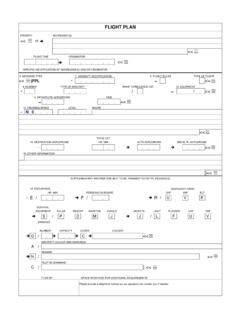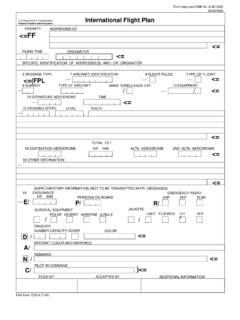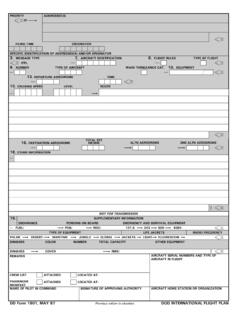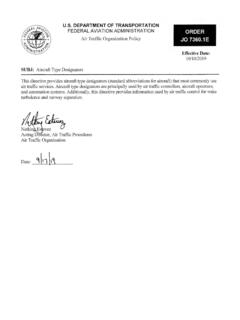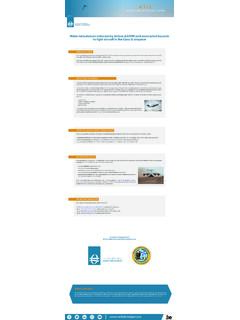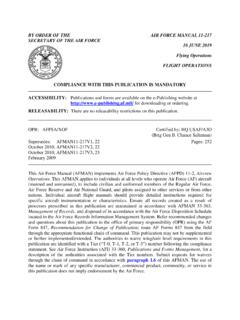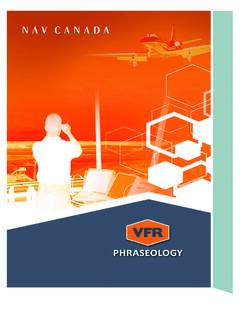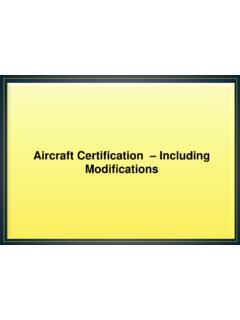Transcription of Aircraft Classifications - 128.173.204.63
1 Aircraft ClassificationsDr. Antonio Trani and Julio Roa Department of Civil and Environmental Engineering. January 20181 The Aircraft and the airport Aircraft Classifications Aircraft characteristics and their relation to airport planningMaterial PresentedLarge capacity Aircraft impacts2 Aircraft Classifications are useful in airport engineering work (including terminal gate sizing, apron and taxiway planning, etc.) and in air traffic analyses Most of the airport design standards are related to Aircraft size ( , wingspan, Aircraft length, Aircraft wheelbase, Aircraft seating capacity, etc.) Airport fleet compositions vary over time and thus is imperative that we learn how to forecast expected vehicle sizes over long periods of timeRelevance of Aircraft CharacteristicsThe Next Generation (NextGen) air transportation system will have to accommodate to a more diverse pool of aircraft3 Airport Engineering and Aircraft CharacteristicsBoeing 737-800 Landing at Runway 36L in Charlotte ( )Important to know the performance aspects of the Aircraft on the ground (low taxiing speeds) as well as on takeoff and landing4 Web Sites to Learn to Recognize Various Aircraft Pictures taken by the author at various airport ( ) Airliners site Jetphotos ( )
2 5 Aerospatiale ATR-42-500 Airbus A380-800 ICAO - International Civil Aviation OrganizationProvides guidance about airport design in all countries of the WorldFAA design standards and ICAO standards are trending to the same values with time6 ICAO Documents 9157 - Aerodrome Design ManualICAO Aerodrome Reference Code used in Airport DesignICAO Aerodrome Reference CodeCode Element 17 Code NumberAeroplane Reference Field Length (meters)1 Less than 8002800 but less than 120031200 but less than 18004 More than 1800 Design GroupWingspan (m)Outer Main Landing Gear Width (m)ABCDEFICAO Aerodrome Reference Code used in Airport Geometric DesignICAO Aerodrome Reference CodeCode Element 2 Example AircraftAll single engine Aircraft , Some business jetsCommuter Aircraft , large business jets (EMB - 120, Saab 2000, Saab 340, etc.)
3 Medium-range transports (B727, B737, MD-80, A320)Heavy transports (B757, B767, MD-80, A300)Heavy transport Aircraft (Boeing 747, A340, B777)A380, Antonov 225< 1515 to < 2424 to < 36 36 to < 5252 to < 6565 to < 80< to < 6 6 to < 99 to < 149 to < 14 14 to < 168 Federal Aviation Administration Runway Design Code (RDC) 9 Combines three classification criteria to define the design specifications of each runway of the airport: Aircraft Approach Code (AAC) Aircraft Design Group (ADG) Approach visibility minimums A fourth classification - called Taxiway Design Group (TDG) is also used in airport design The following slides provide some insight about each classification schemeNote: An airport may have different RDC standards for different runways For example, a runway used for air carrier operations may use a higher RDC standard than a runway used for General Aviation OperationsExample: Baltimore-WashingtonInternational (BWI)10 Runway 33 Used by General Aviation aircraftRunway 28 Used by air carrier aircraftsource.
4 Google EarthDesign GroupRepresentative Aircraft TypesIIIIIIIVVVIF ederal Aviation Administration Aircraft Design Group (ADG) Wingspan (feet)Cessna 172, Beech 36, Cessna 421, Learjet 35 Beech B300, Cessna 550, Falcon 50, Challenger 605 Boeing 737, Airbus A320, CRJ-900, EMB-190 Boeing 767, Boeing 757, Airbus A300, Douglas DC-10 Boeing 747, Airbus A340, Boeing 777 Airbus A380, Antonov 225*< 2020 to < 3030 to < 45 45 to < 6060 to < 6666 to < 80< 4949 to < 79 79 to < 118118 to < 171171 to < 214 214 to < 262 Tail Height (feet)* The Antonov 225 has a wingspan of 290 feet (in a class by itself). Only one Aircraft Aviation Administration Aircraft Design Group (ADG) 12source: Table 1-2 of FAA AC 150/5300-13A Note: Always use the most critical dimension of the two criteria shown in Table 1-1 GroupABCDEA irport Terminal Area Procedures Aircraft Classification (FAA Scheme)FAA Aircraft Approach Speed Classification (AAC)Example AircraftAll single engine Aircraft , Beechcraft Baron 58 Business jets and commuter Aircraft (Beech 1900, Saab 2000, Saab 340, Embraer 120, Canadair RJ, etc.)
5 Medium and short range transports (Boeing 727, B737, MD-80, A320, F100, B757, etc.)Heavy transports (Boeing 747, A340, B777, DC-10, A300)BAC Concorde and military Aircraft < 9191 to < 121121 to < 141 141 to < 166>= 166 Approach Speed (knots) maximum landing Appendix 1 in FAA Advisory Circular 150/5300-13A for a complete listing of Aircraft approach speeds13 FAA Aircraft Approach Speed Classification (AAC)14 Aircraft approach speeds are taken at maximum allowable landing weight For the same Aircraft , approach speeds vary by weight For typical commercial Aircraft , approach speeds can vary as much as 15-20 knots between maximum landing weight and empty operating weight)source.
6 Table 1-1 of FAA AC 150/5300-13A Example of Aircraft Approach Speed Variations15 Consider the Airbus A340-500 - a long-range aircraftsource: Airbus A340-500 Airplane Characteristics for Airport Planning Approach speed at 180,000 kg landing weight ~ 125 knots Approach speed at 300,000 kg landing weight (maximum allowable landing mass) ~ 160 knotsApproach Speed (knots)Max. Allowable Landing Weight 300,000 kgFAA Advisory Circular AC/150 5300-13 Airport Design (Appendix I)Source to Find Aircraft Approach Speed and Aircraft Mass (weight) Data 16 Table A1-1. Aircraft characteristics database - sorted by Aircraft manufacturer modelPresentation of Aircraft Characteristics in Appendix I of AC 150/5300-13 AAircraft Approach ClassAircraft Design GroupTaxiway Design Group17 Approach Visibility MinimumsDefined by a parameter called Runway Visual Range (RVR) RVR is the range over which the Pilot of an Aircraft on the centre line of a runway can see the runway surface markings or the lights delineating the runway or identifying its centre line.
7 (ICAO)RVR Equipment18 Approach Visibility MinimumsInstrument Landing System Categoriessource: Table 1-3 of FAA AC 150/5300-13A 19 Recap: Runway Design Code (RDC)Three parameters are combined to derive a so-called Runway Design Code (RDC) AAC, ADG and Approach Visibility MinimumsRDC provides three parameters needed to determine design standards for an airportNote: for most airport design projects the TDG parameter is also critical to determine taxiway-to-runway distances 20 Previous FAA guidance considered tail height and wingspan as design factors for geometric designNew guidance implemented in September 2012 considers: - Dimensions of the Aircraft undercarriage- Main gear width (MGW)- Cockpit to main gear dimensions (CMG)Taxiway Design Group (TDG)21 FAA AC 150/5300-13A Appendix IFigure A1-1.
8 Typical dimensions of large aircraft22 FAA AC 150/5300-13A Appendix IFigure A1-2. Typical dimensions of small aircraft23 FAA specifies:Cockpit to Main Gear (CMG) dimension will be used instead of the Aircraft wheelbase for Aircraft where the cockpit is located forward of the nose gear (typically applies to commercial Aircraft ) For Aircraft with the cockpit located aft of the nose gear, use the wheelbase instead of CMG to determine the Taxiway Design Group (TDG)See figures in the previous slidesCMG Distance vs Wheelbase Distance24 Examples : Small AircraftCirrus SR-204-seat single engine piston power aircraftMany general aviation Aircraft (called GA) typically have the nose gear located in front of the cockpit (use the wheelbase distance for design)Cessna Citation Excel 560XL Twin turbofan powered aircraft25 Examples - Commercial AircraftAirbus turbofan powered, commercial aircraftMost commercial Aircraft have the cockpit located ahead of the nose gear (use CMG distance)Cockpit to Main Gear Distance (CMG)
9 26cSpecial Landing Gear ConfigurationsPiper J-3 Cub2-seat single engine piston power aircraftTail Dragger ConfigurationSome Aircraft have special landing gear configurationsBAC Concorde - Supersonic Transport (very long CMG distance) 27 Taxiway Design Group DefinitionsFigure 4-1. Taxiway Design Groups (TDGs) source: FAA AC 150/5300-13A28 Our website, excel file cee4674/cee4674_ aircraft_char_database/ Aircraft Characteristics FAA siteEurocontrol site29 Excel file with Aircraft data cee4674/cee4674_ aircraft_char_database/ Sample Excel Database of Aircraft CharacteristicsAvailable at:30 Example Problem #1An airport is to be designed to accommodate the Boeing 757-300 Aircraft .
10 Determine the airport reference code and the taxiway design group to be :Look at the FAA Aircraft database:Approach speed is 143 knots (AAC = D) and Wingspan is feet and tail height feet (thus group IV)31 Picture the Aircraft in Question (Sanity Check)Boeing 757-300 taking off at Punta Cana International Airport ( ) Aircraft pictures are available at: Problem #1 Boeing 757-300 :Approach speed is 143 knots (AAC = D) and Wingspan is feet and tail height feet (belongs to ADG group IV)Boeing 757-300 Belongs to Group IVReason: tail height falls into III group, wingspan belongs to group IVUse the most critical33 Note: The most critical element for this Aircraft is the wingspan (tail height fits into III) Example Problem #1 Boeing 757-300 has a wheelbase of feet, a Main Gear Width of feet ( meters) and a Cockpit to Main Gear distance of feet (26 m)Boeing 757-300 Belongs to Taxiway Design Group (TDG) 434 Boeing 757-300 has a wheelbase of feet, a Main Gear Width of feet ( meters) and a Cockpit to Main Gear distance of feet (26 m)Boeing 757-300 Belongs to Taxiway Design Group (TDG)
